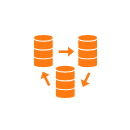Data Management solutions help you address today's data problems while giving you a plan for the future. For any organization, data management technology is the fuel behind every process. We design with IT and business collaboration in mind to help you transform big data into big opportunity.
- Data integration solutions involve combining data residing in different sources and providing users with a unified view of these data.
- These process at Tungsten have become significant in a variety of situations, which include both commercial (when two similar companies need to merge their databases) and scientific (combining research results from different bioinformatics repositories, for example) domains.
- Data integration frequency has increased over time as the volume and the need to share existing data explodes. It has become the focus of Tungsten's deliveries, and numerous open problems remain unsolved.
- "Enterprise Information Integration" is the new name of the same thing in our client circles
- Simply put, within data quality management we undertake establishment and deployment of roles, responsibilities, policies, and procedures concerning the acquisition, maintenance, dissemination, and disposition of data.
- We help establish partnership between the business and technology groups which is essential for any data quality management effort to succeed. The business areas are responsible for establishing the business rules that govern the data and are ultimately responsible for verifying the data quality.
- We work with the Information Technology (IT) group which is responsible for establishing and managing the overall environment - architecture, technical facilities, systems, and databases - that acquire, maintain, disseminate, and dispose of the electronic data assets of the organization.
- A typical ERP system as a minimum will have a Customer Master, an Item Master, and an Account Master. This master data is often one of the key assets of a company. It's not unusual for a company to be acquired primarily for access to its Customer Master data.
- We work with organizations on various facets of data like Unstructured, Transactional, Metadata, Hierarchical, Metadata, Master
- Using MDM, you get to decide how to manage by taking into aspects of behavior, data life cycle, cardinality, lifetime, complexity, value and volatility.
- Tungsten's MDM toolkit incorporates steps as detailed below:
- An MDM project plan will be influenced by requirements, priorities, resource availability, time frame, and the size of the problem. Most MDM projects include at least these phases:
- Identify sources of master data. This step is usually a very revealing exercise. Some companies find they have dozens of databases containing customer data that the IT department did not know existed.
- Identify the producers and consumers of the master data. Which applications produce the master data identified in the first step, and—generally more difficult to determine which applications use the master data.
- Collect and analyze metadata about for your master data. For all the sources identified in step one, what are the entities and attributes of the data, and what do they mean? This should include attribute name, datatype, allowed values, constraints, default values, dependencies, and who owns the definition and maintenance of the data.
- Appoint data stewards. These should be the people with the knowledge of the current source data and the ability to determine how to transform the source into the master-data format
- Implement a data-governance program and data-governance council. This group must have the knowledge and authority to make decisions on how the master data is maintained, what it contains, how long it is kept, and how changes are authorized and audited.
- Develop the master-data model. Decide what the master records look like: what attributes are included, what size and datatype they are, what values are allowed, and so forth.
- Choose a toolset. You will need to buy or build tools to create the master lists by cleaning, transforming, and merging the source data. You will also need an infrastructure to use and maintain the master list
- You can use a single toolset from a single vendor for all of these functions, or you might want to take a best-of-breed approach
- Design the infrastructure. Once you have clean, consistent master data, you will need to expose it to your applications and provide processes to manage and maintain it
- Generate and test the master data. This step is where you use the tools you have developed or purchased to merge your source data into your master-data list.
- Modify the producing and consuming systems. Depending on how your MDM implementation is designed, you might have to change the systems that produce, maintain, or consume master data to work with the new source of master data.
Tungsten's Mobile BI Consulting offer a portfolio of tools and services to develop enterprise mobility strategies so you can create a mobile enterprise that capitalizes on new business models, innovates products and services, and unlocks workforce productivity. With technology expertise and industry knowledge, our BI & mobility consultants will work with you to develop your organization's mobile blueprint and implement across a diverse range of mobile platforms and devices.
- Access the business intelligence you need to make critical decisions - anytime, anywhere, and on any device. Tungsten Mobile BI services deliver real - time visibility into big data with a secure, immersive mobile experience that features interactive visuals and intuitive search.
- Make more informed decisions with immediate access to online and offline information
- Deliver engaging mobile reports to drive better decisions and productivity
- Provide sales and field reps with the data they need to answer customer questions on the spot
- Boost the productivity and effectiveness of workers in the field
- Keep business processes running smoothly by monitoring KPIs from the road
- Lower total cost of ownership through reuse of deployed BI reports and platform functionality
Empower your people with easy access to the business intelligence (BI) and data visualization tools solutions they need to make faster, more informed decisions. Our BI services can boost your organization's collective IQ by giving all users the information necessary to drive smarter processes, improve performance, and become more effective in everything they do.
- Tungsten helps you enable to quickly build and deploy web-based dashboards, reports, and interactive visual analytics and deploy them to any size audience for a single price. Unlike traditional BI solutions, you can be up and running in days, not months, and unlike tool sets, you can easily manage your apps to suit changing end-user needs.
- We even build solutions that let end-users build, save, and manage their own views of their data, all while retaining the control and security you require. Best of all, you can serve as many users as you want without growing your cost.
- Tungsten solutions includes the latest analysis features, including interactive dashboards and scorecards, drill-down and drill- through reporting, advanced charting, gauges, and GIS maps.
- It also provides workflows including email, schedules, alerts, database management, and database write-backs.
Data Re-architecture for Large Financial Services Firm
The Customer
A premier Tier 1 Investment bank offering a full spectrum of solutions to large corporate, government and institutional clients to their strategic advisory, financing and risk management needs.
Business Scenario
Leading Capital Market Solution Provider provides Data Management and Investment Management solutions. Their core product creates a copy an Organization's data, related with Trades, Security and Custody information. Client has the following challenges with the current offerings:
- The data model offering is not suited for Data warehousing and analytical reporting owing to its highly normalized data structure
- The client has built a Data Warehouse solution which will be coupled with existing data model to cater to all analytical reporting needs. However, the new DW solution is unable to deliver the expected performance due to several design anomalies
Tungsten's Solution
Conducted an Architectural assessment of the existing data model and provided the following high-level recommendations
- Extend the DW data model to meet the majority of the reporting requirements common for most clients
- Segregate analytical and operational reporting
- Build conformed dimensions that can be reused for analytical and operational reporting needs
- Apply dimensional data modeling standards and techniques
- Apply data de-normalization techniques to eliminate performance bottlenecks and improve efficiency
- Suggested efficient design approaches to store, retain and report historical data
Features and business benefits of the solution
- Enhanced functionality and client's core offerings to include analytical reporting
- Improved performance of the Data Warehousing solution to handle high query volumes
- Improved Time-to-Market for product implementation through adherence to standards and best practices
- Improved data quality resulting in better user confidence in data
- True global usage of DM
- Enhanced user experience through improved visibility to data and increased system availability







 ETL & Data Integration
ETL & Data Integration Data Quality
Data Quality Master Data Management
Master Data Management Mobile Dashboards
Mobile Dashboards Field Reporting
Field Reporting Batch & Canned Data Reporting
Batch & Canned Data Reporting Dashboard & Universe Creation
Dashboard & Universe Creation